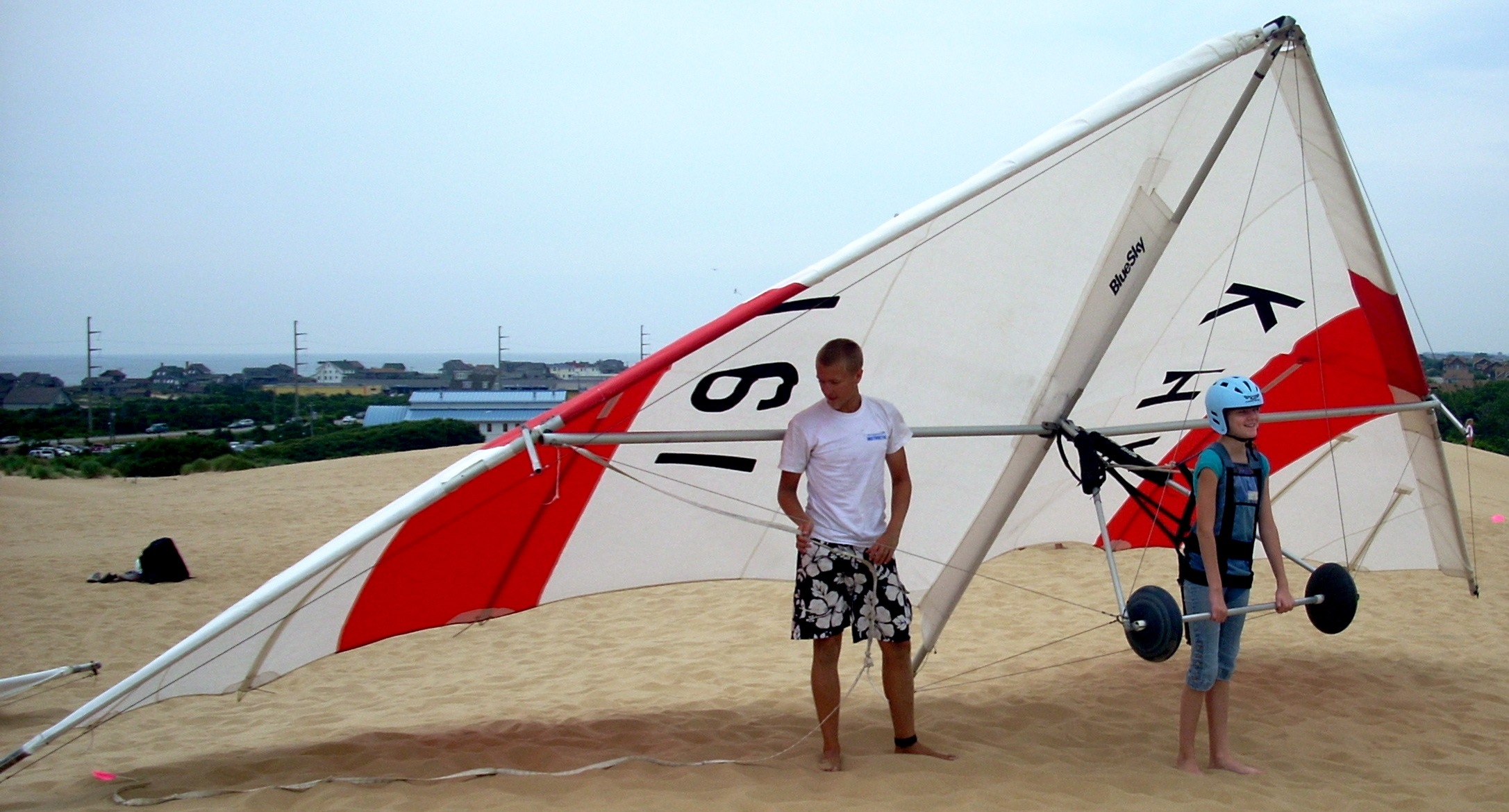
Hang Gliding
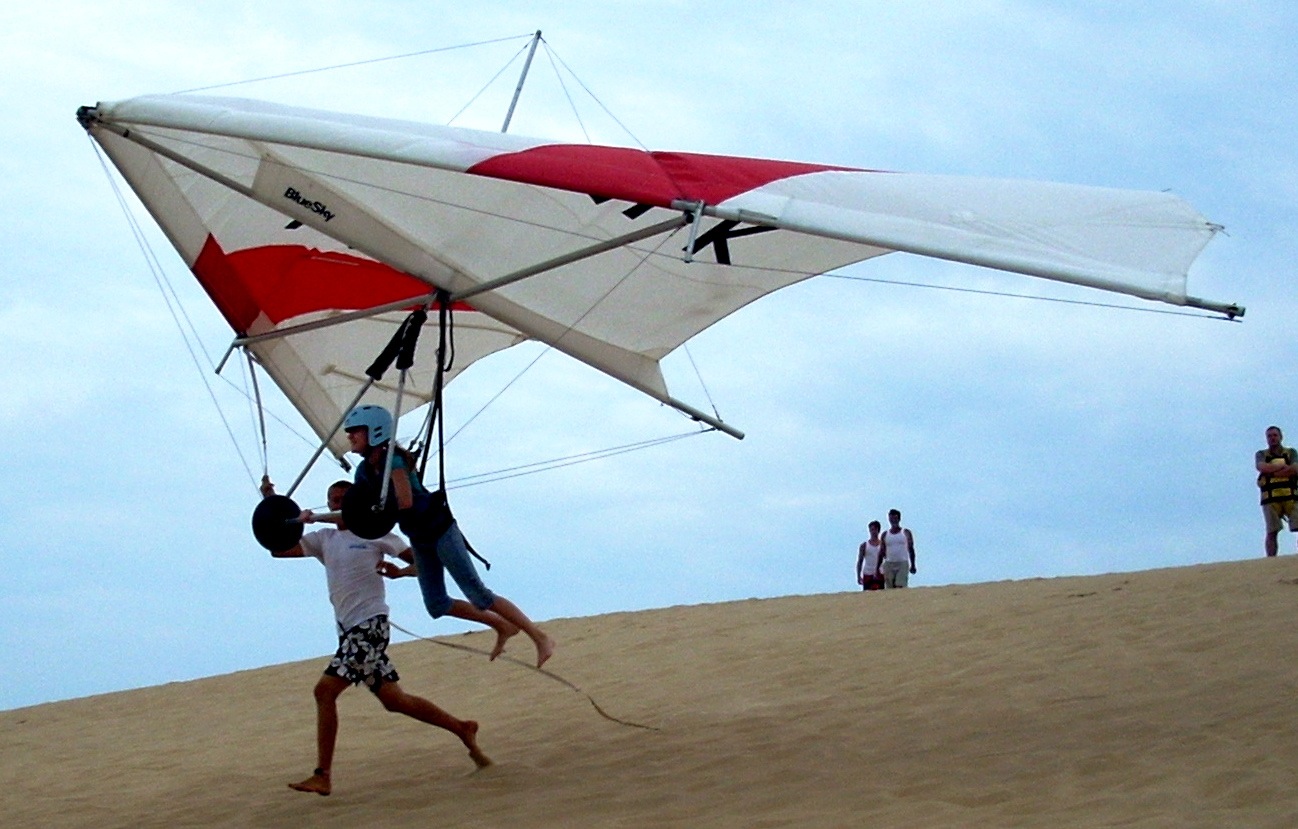
| Route 66 | Cities | Beaches |
 |
Hang Gliding |
 |
|
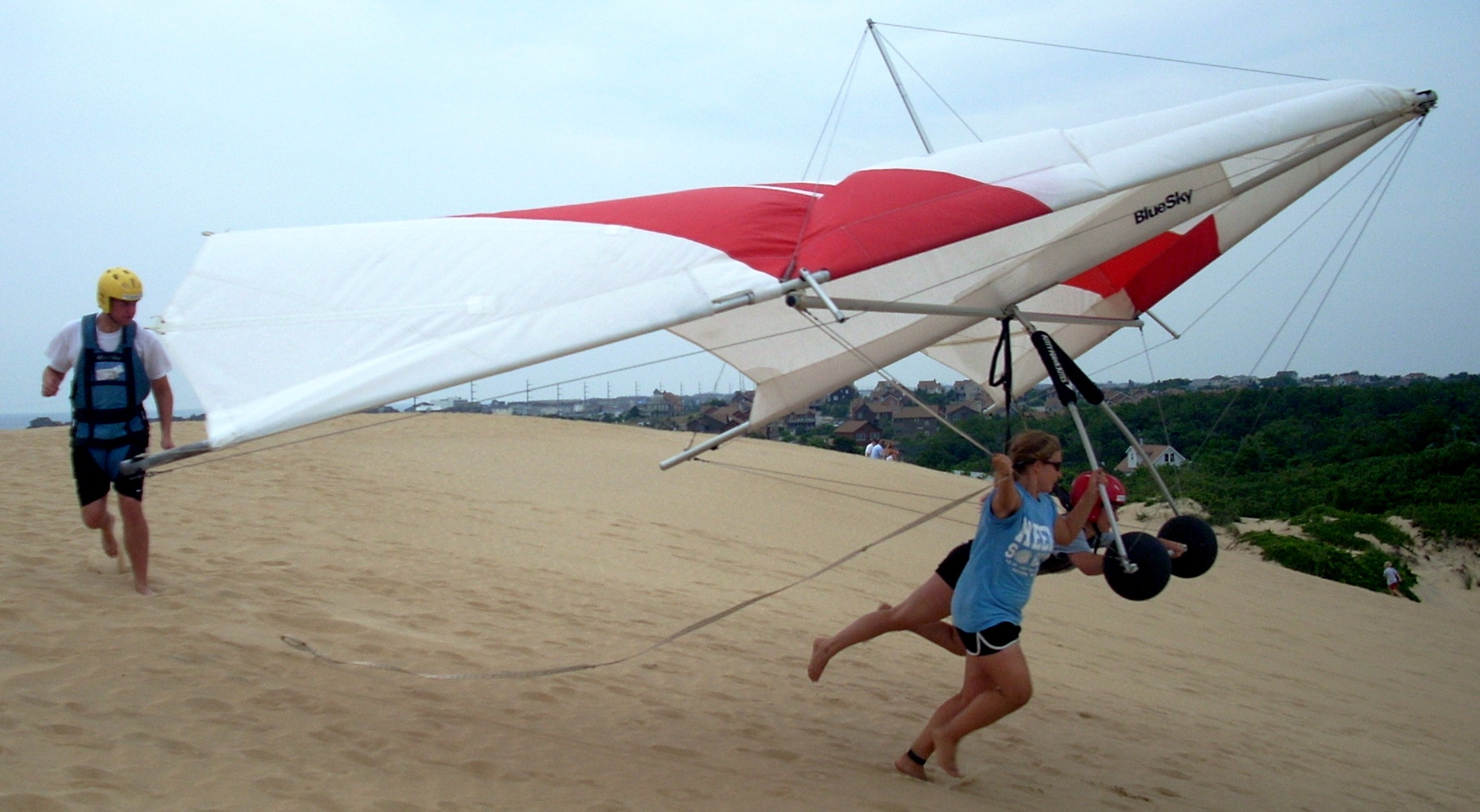 |
Hang Gliding may be the ultimate Hatteras experience. Most kids have seen it on tv or in magazines, but back home it is much too dangerous, not to mention expensive, to actually try. Down here, it becomes a very safe and affordable adventure that lends itself to great photos. Like several other activities described here, Hatteras is the world capital of hang gliding. The high dunes, deep soft sand and steady winds are why the Wright brothers came here to test their airplanes. And these hang gliders are the naturally evolved high tech versions of the original Wright brothers double wing air machines. These are not only the same dunes Wilbur and Orville used, but from where these pictures are taken, you can look over and see the marked sites where they launched from and landed. To do this you need to drive to the north end of Hatteras Island, cross the Bonner Bridge over Oregon Inlet, and as you see Jockey Ridge loom on the horizon to your left, pull into the Kitty Hawk Kites parking lot on your right. |
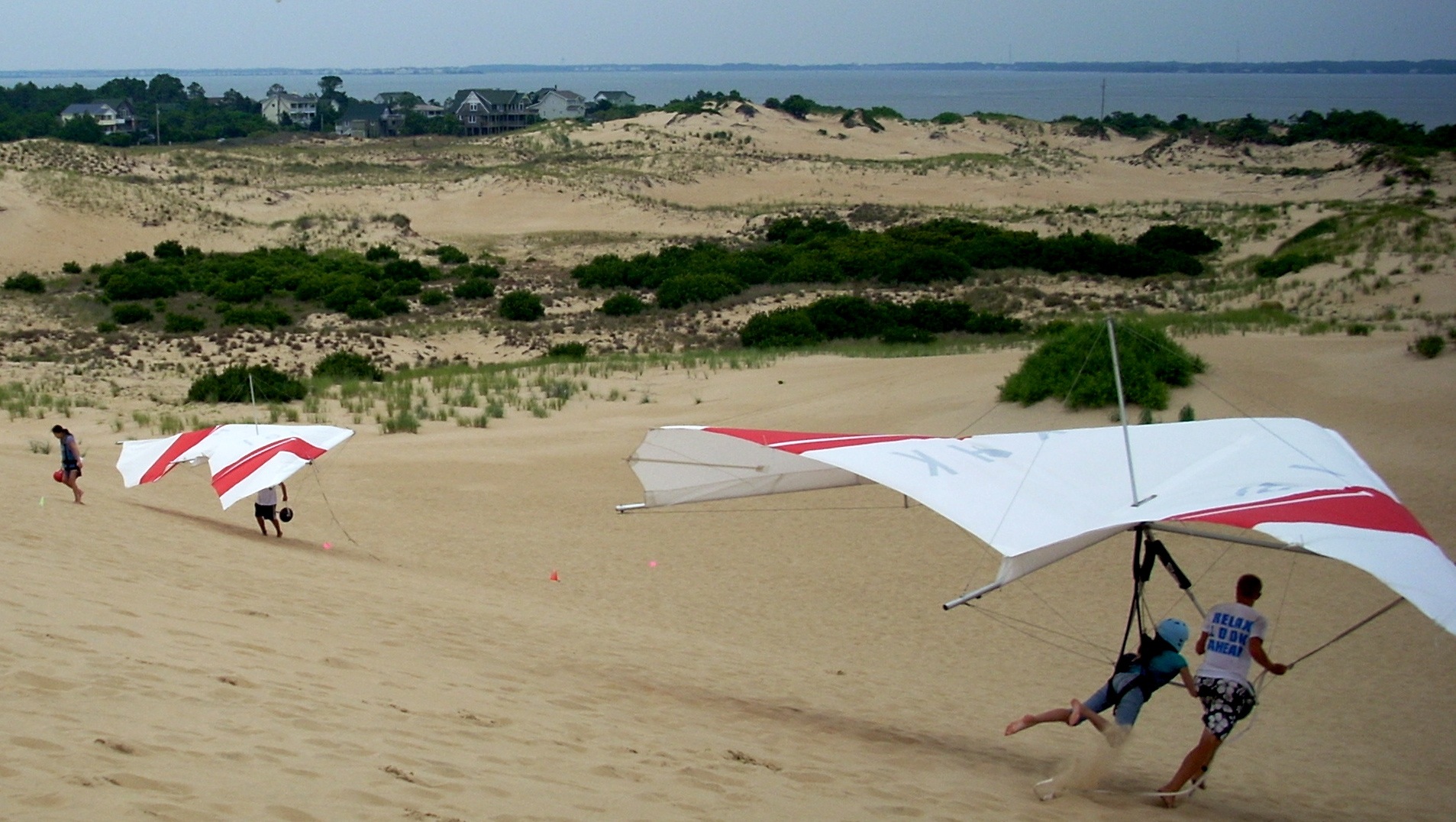 |
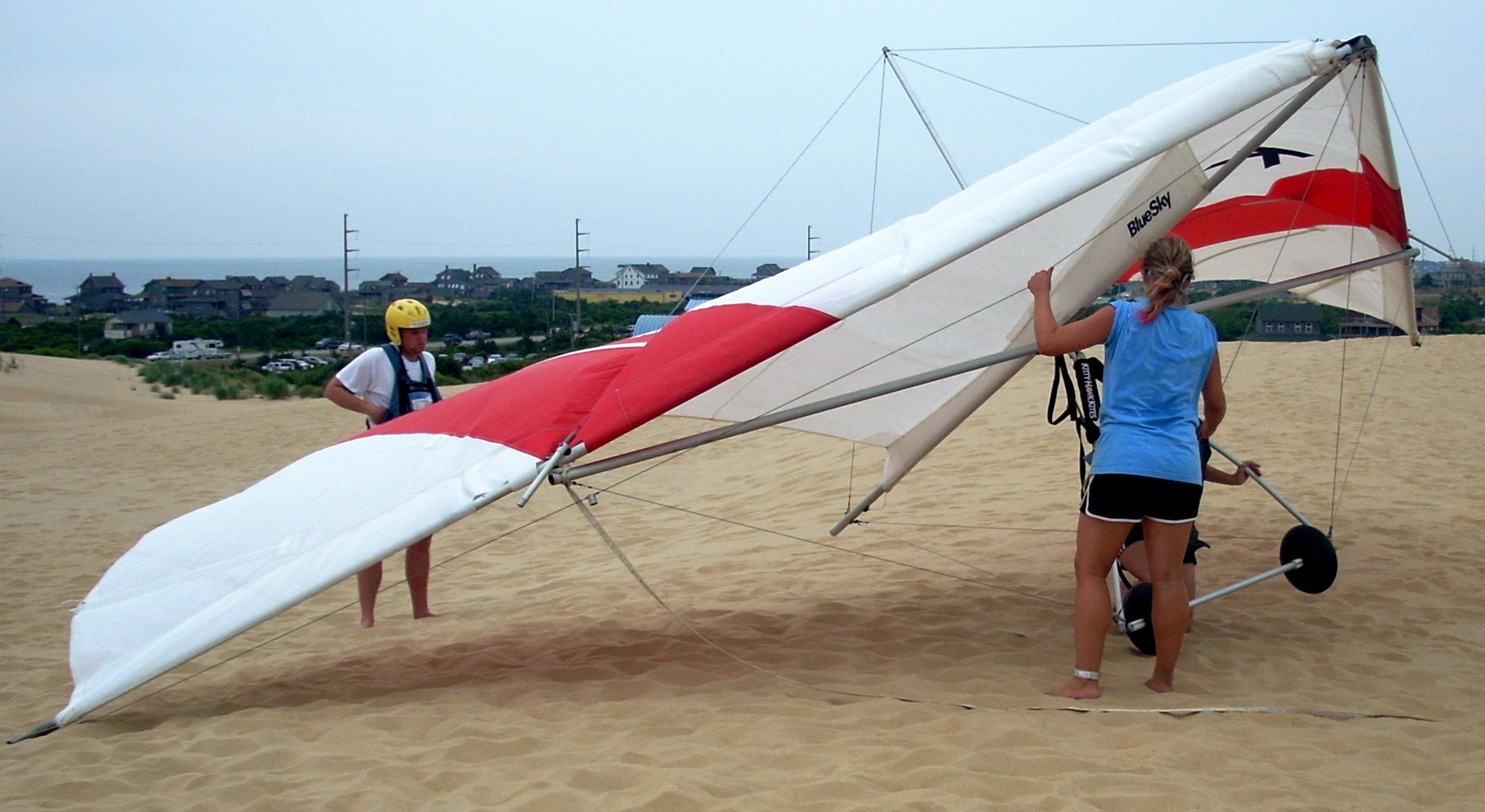 |
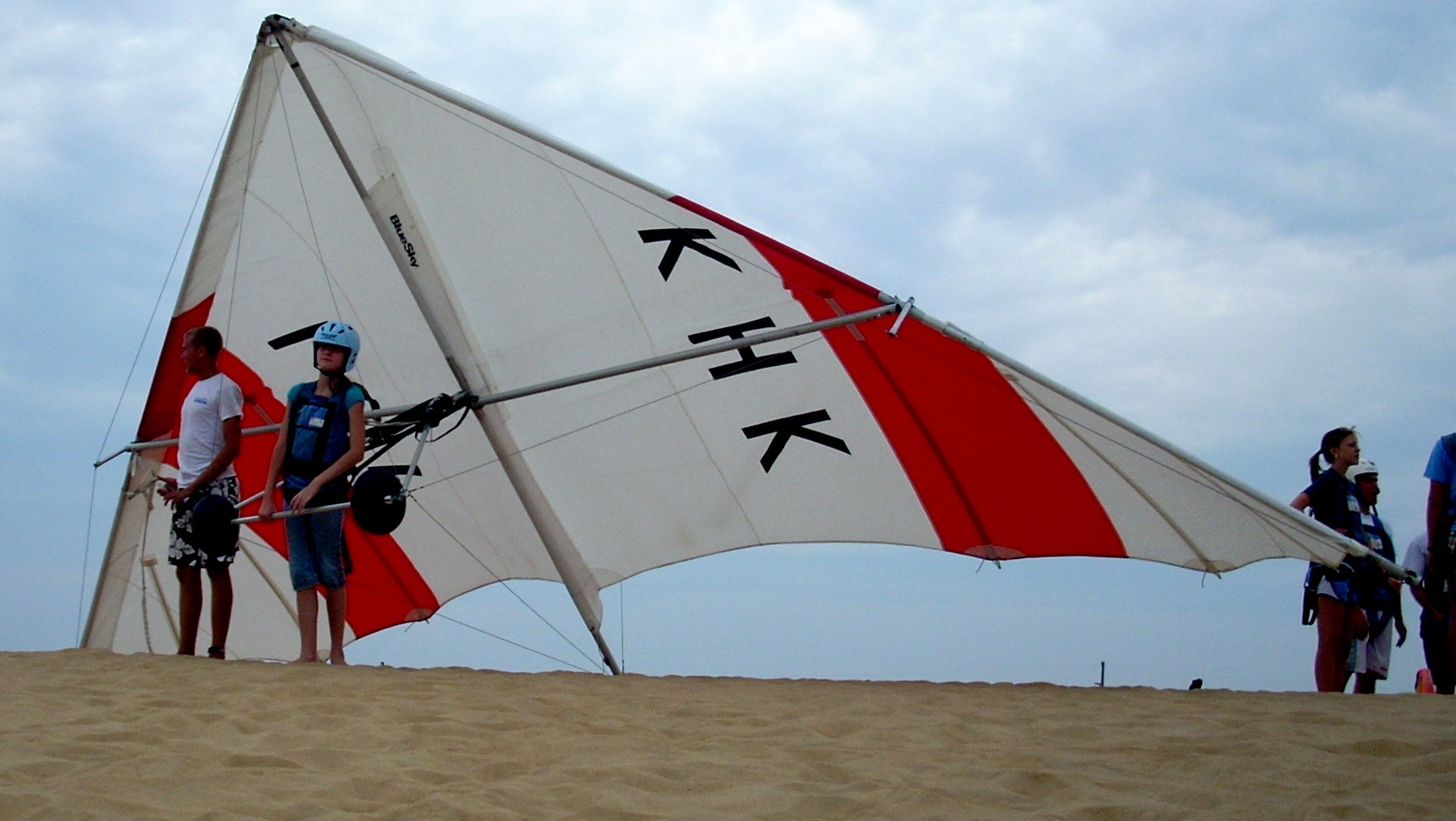 |
| The introductory lesson is a three hour all morning session which includes the equipment shown here. After learning about basic principles and safety, you hike up the dune. You learn about steering, positioning and the safety harness. Then, when it comes time to fly, your instructor accompanies you down the hill "flying" your rig like a kite. You can steer right or left, up or down, so within certain parameters you have control and learn how to deal with wind currents and the descending glide patterns. But if you wander too far off course (below left), the instructor uses the guide ropes to nudge you back. During the first session, the instructor won't let you soar too high. Once you've had lots of practice landing and know how to come down softly from various speeds and angles and in various winds, you'll be allowed further off the ground. There's an adrenalin rush that comes as you become airborn, and after three hours you'll be thoroughly exhausted. |
|
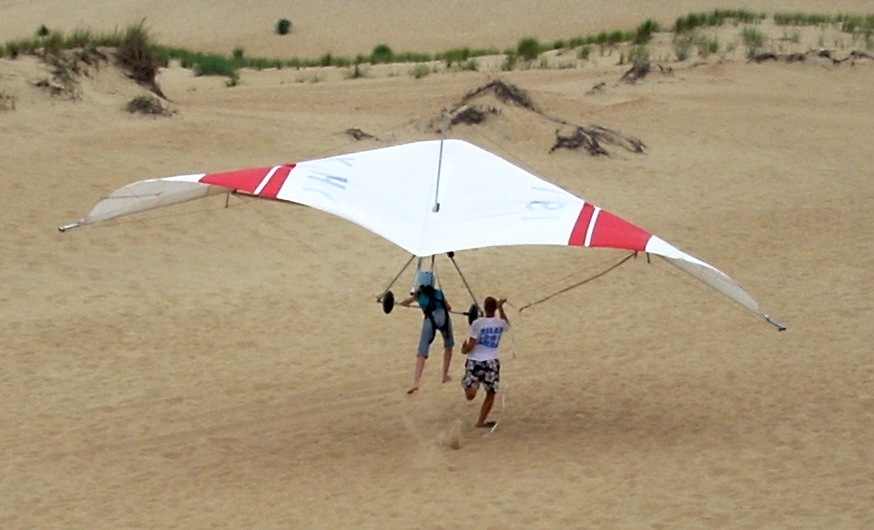 |
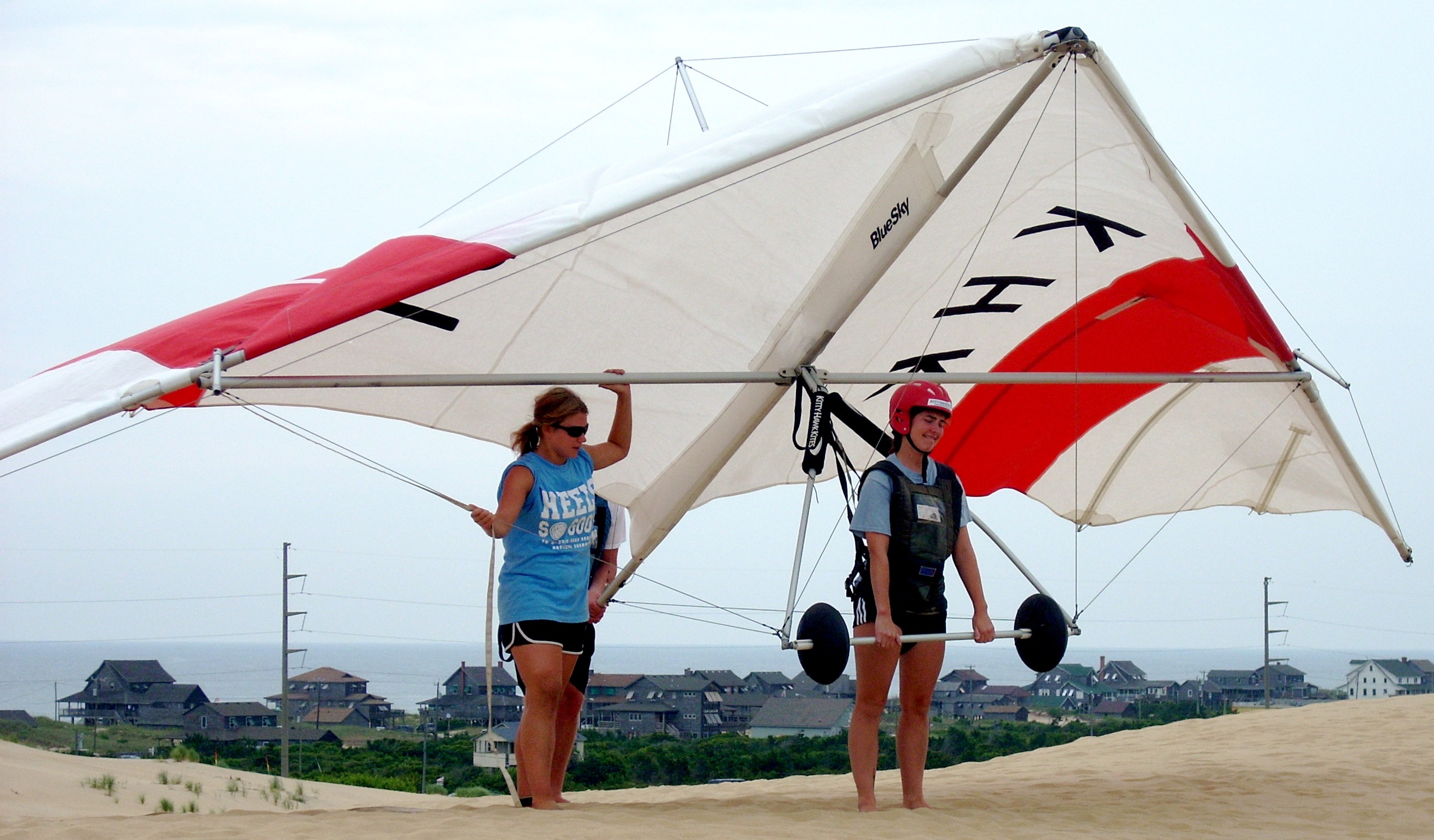 |
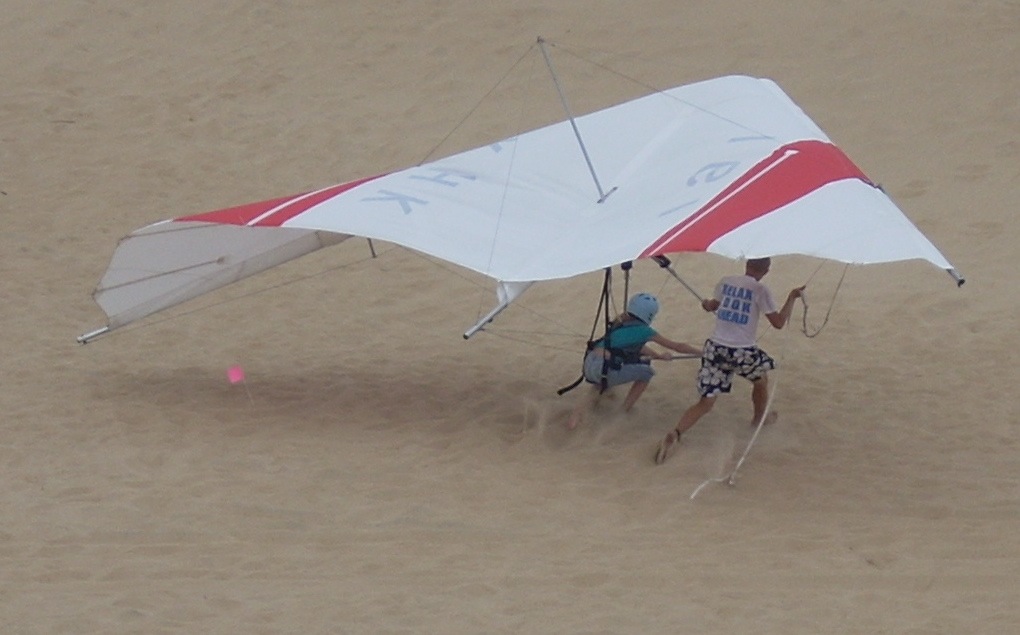 |
|
The usual sequence is for a new student to take the first hour digesting all the safety and fundamental information and becoming comfortable with the equipment. The first few "flights" are usually similar to skiing or riding a bicycle : there's a lot of awkwardness and the instructor is doing most of the "flying." During the second hour the student usually learns the hang of actually flying, and begins to look like the photo at left here. The third hour is devoted mostly to landings. As seen above right, this is tricky at first. The deep, soft sand cushions mistakes. But there's a real technique to dropping off the rig, touching your legs down, and running the rig to a smooth landing. The setting for all this is spectacular. You're looking out at the ocean to the East, the Sound to your West, and to your immediate right at the Wright Brothers Memorial. The town of Kitty Hawk spreads out below you and there are people hiking up and down the dunes all around. The dune you're on, Jockey Ridge, is the largest dune in North America, and is "live," meaning it continues to move back and forth over time, burying houses and roads for a decade or so and then uncovering them. Down by the road is a castle that recently emerged after 30 years under the sand. |
| Even though this program is run by Kitty Hawk Kites, whose huge store is over on Route 12, the Hang Gliding School Headquarters is in Jockey Ridge State Park. To get there, you continue North past the store for a quarter of a mile, then look for the park entrance to your left. Once you enter the park, the road winds around for half a mile and ends in the Visitor Center parking lot. Look for the large hang glider at the far end of the parking lot, which marks the walkway leading through the tree3s. The Hang Gliding School is across the boardwalk from the Visitor Center. There's a registration counter, a small mechandising center, theatre classroom, and equipment storage center for helmets and harnesses. Each lessons begins with 45 minutes of "ground school" in that theatre classroom and further instruction at the hang glider out by the parking lot. | 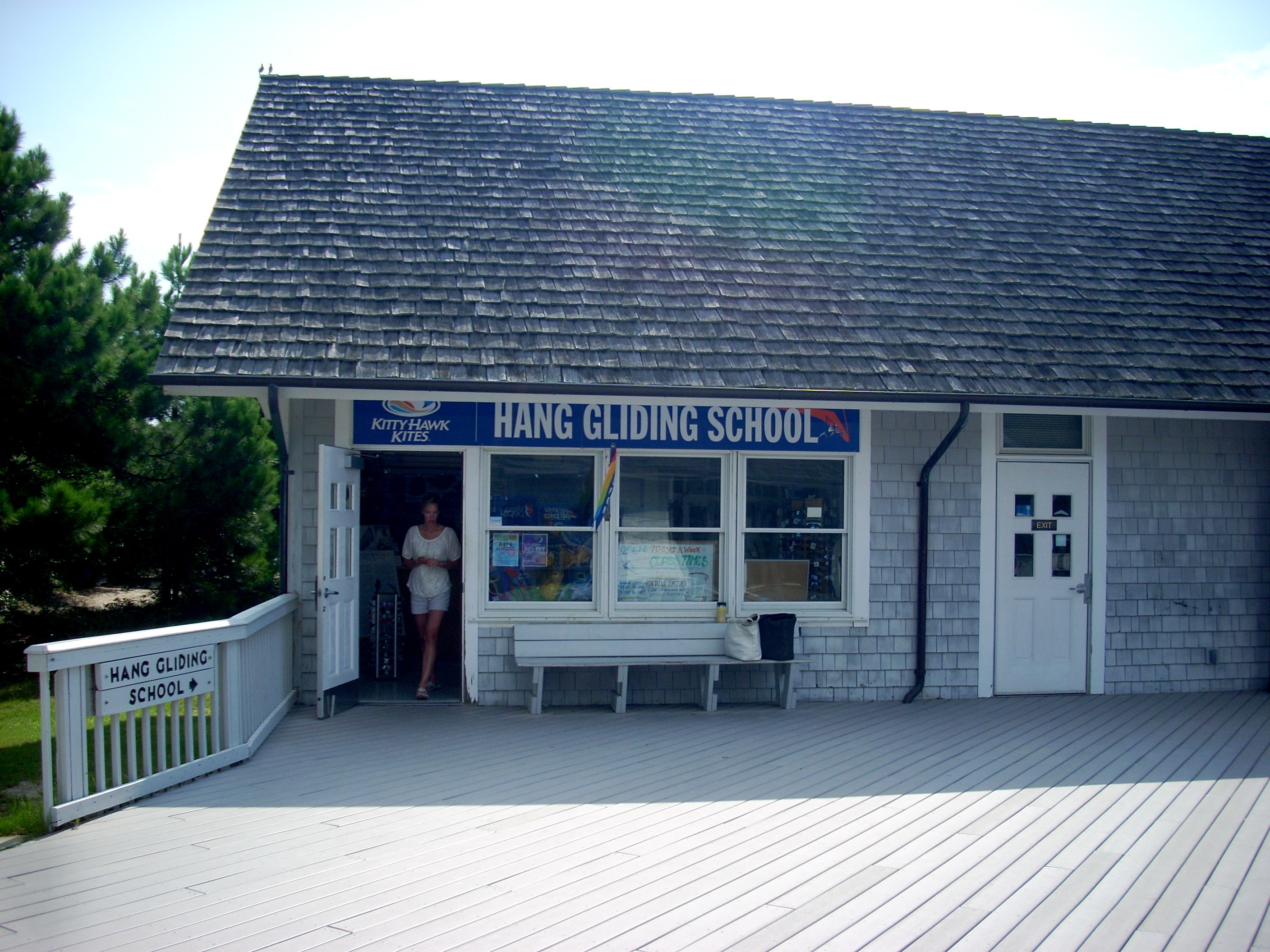 |
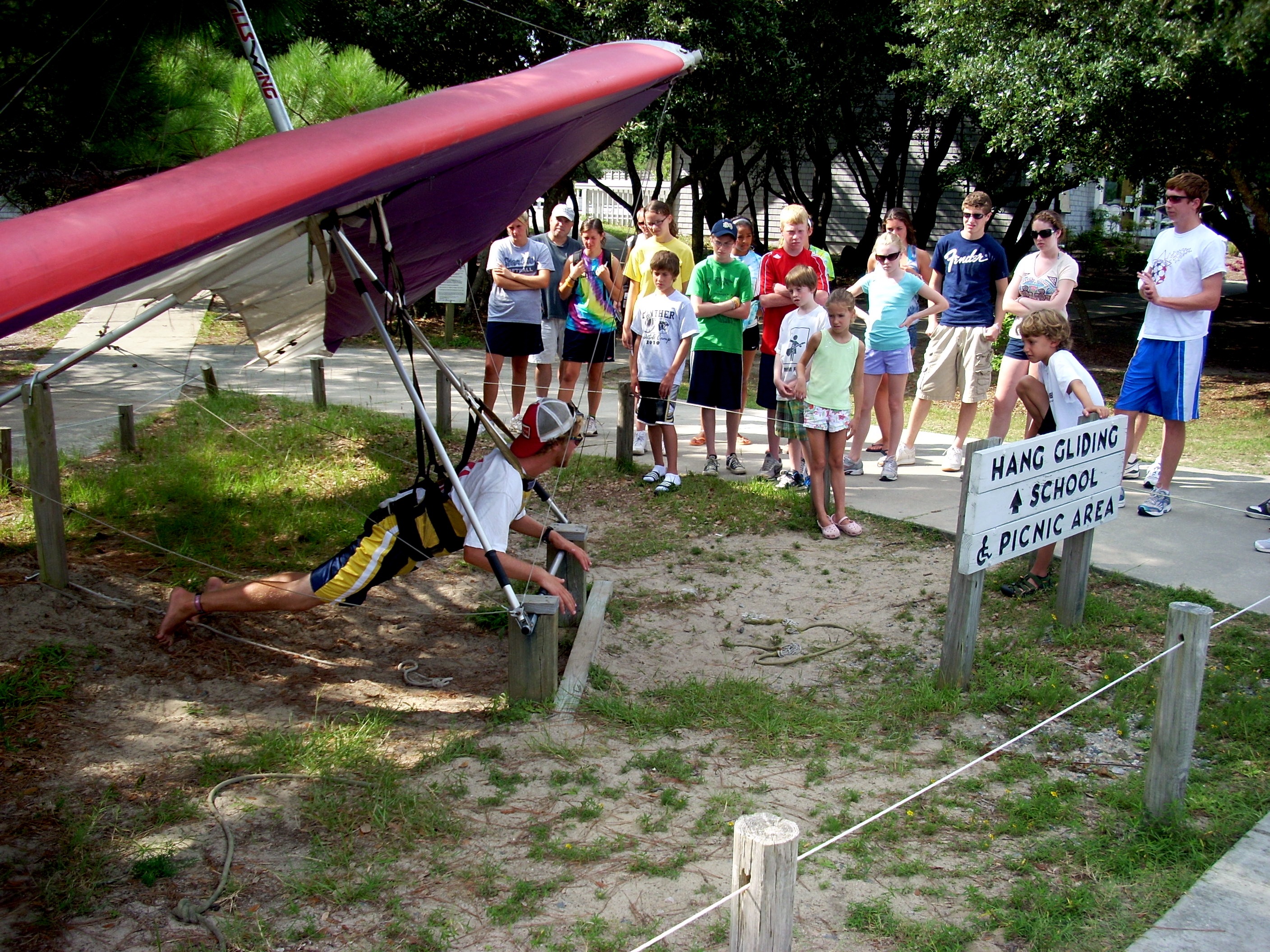 |
Students are drilled over and over in the art of swaying to the right to turn left, swaying left to turn right, pushing the bar forward to raise the front of the sail and rise, pulling the bar back to lower the front of the sail and drop, and safely clipping into and out of the harness hanging from the overhead framework. As can be seen in this photo, a typical class consists of every age from grade school to retirement, with a heavy concentration of high school and college students in the middle. |
| Then it's time to fit everyone with helmets and harnesses, divide the class into five small groups each with its own instructor, and issue flying permits personalized with date, time, student name, instructor name and other pertinent data. The flying permit must be prominently displayed in a plastic window in the safety harness. Students are given time to apply sunscreen and buy or fill water bottles. Then it's time for the hike to the top of the dune. Most students say afterward that the hike up the dune is the hardest part of the three hour course, especially since they have to rehike it every time they complete a flight. It is the highest dune in North America, quite steep, with deep, soft, hot sand. The hang gliders are kept tethered on top of the dune. | 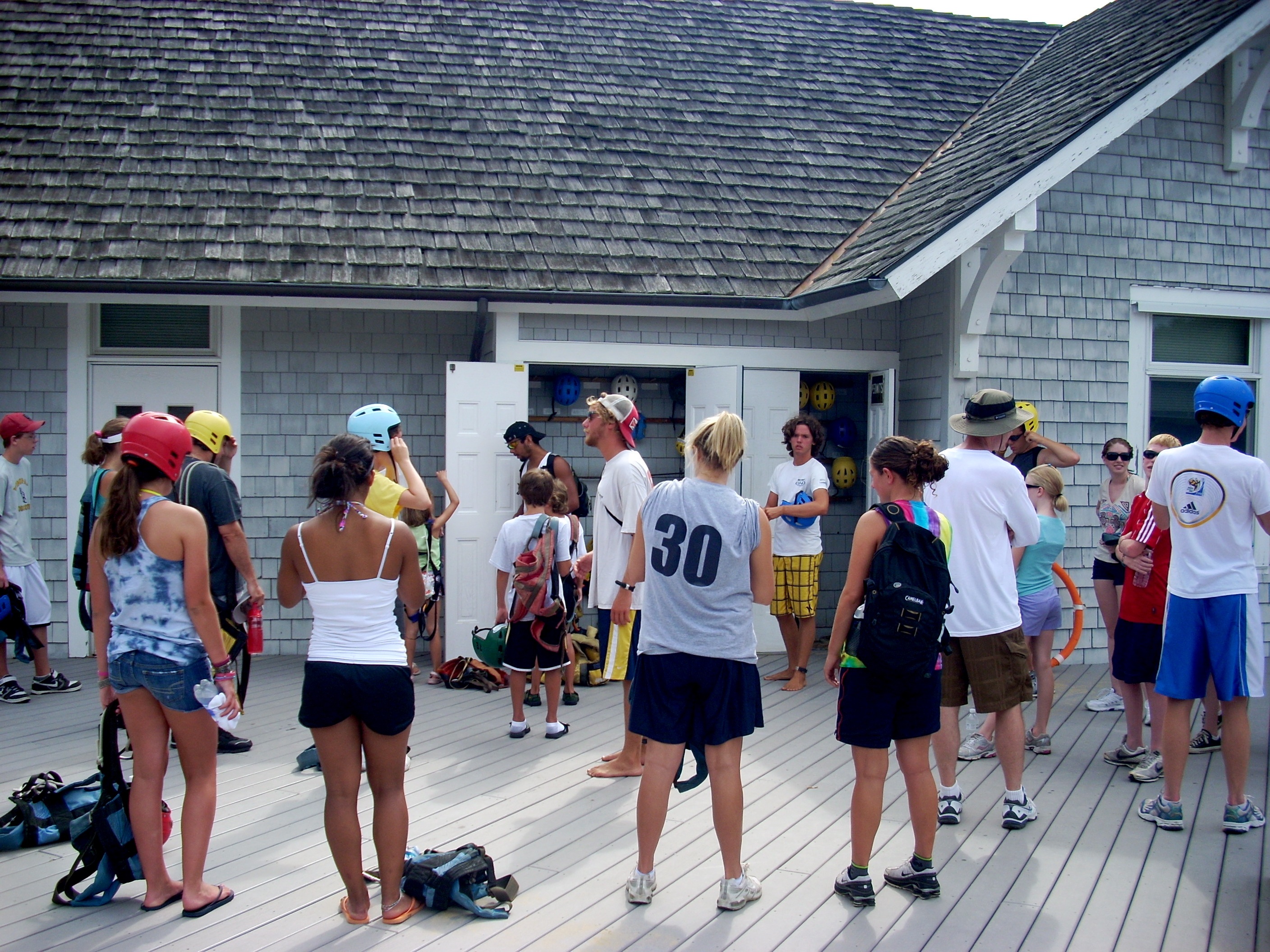 |
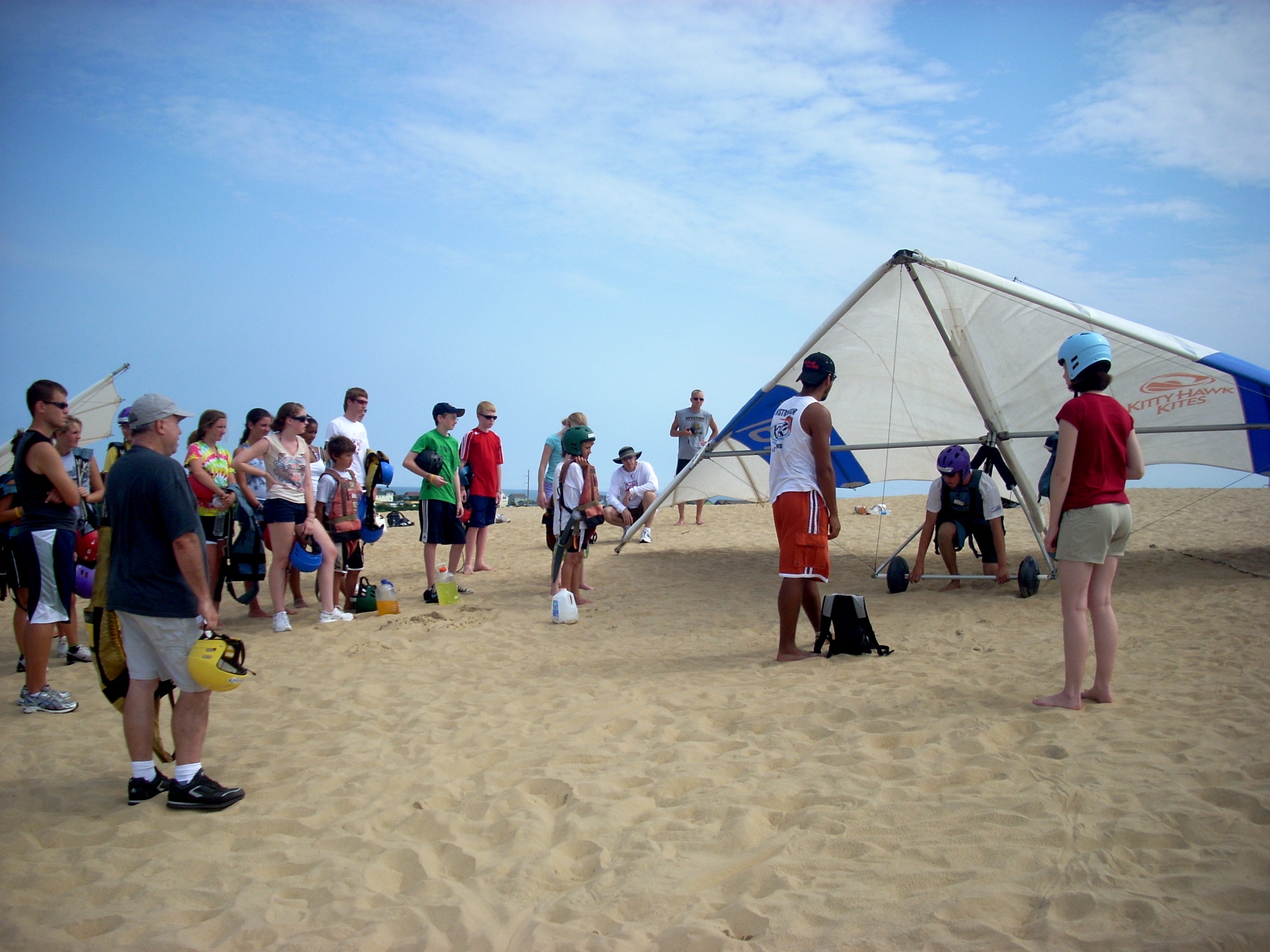 |
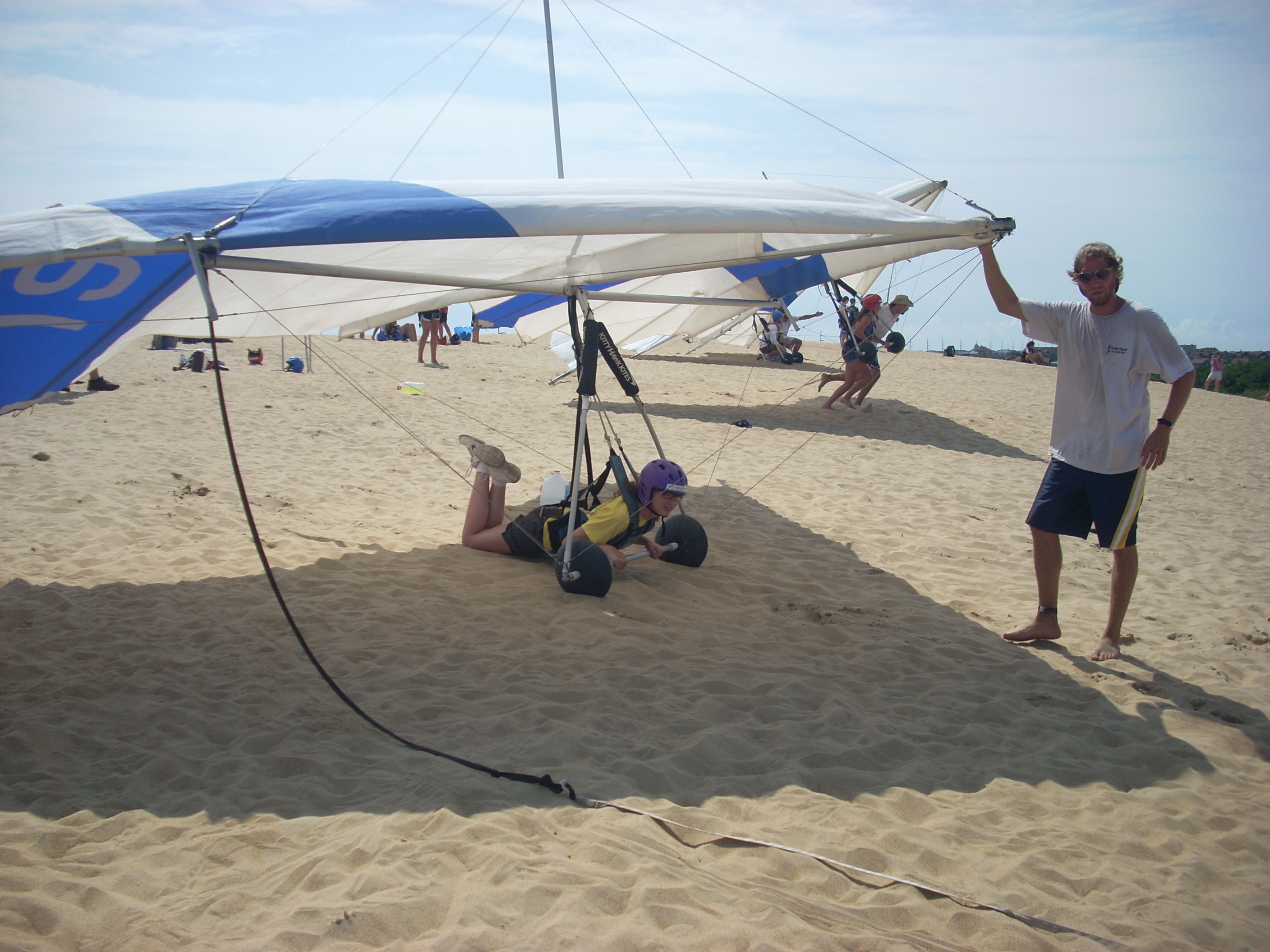 |
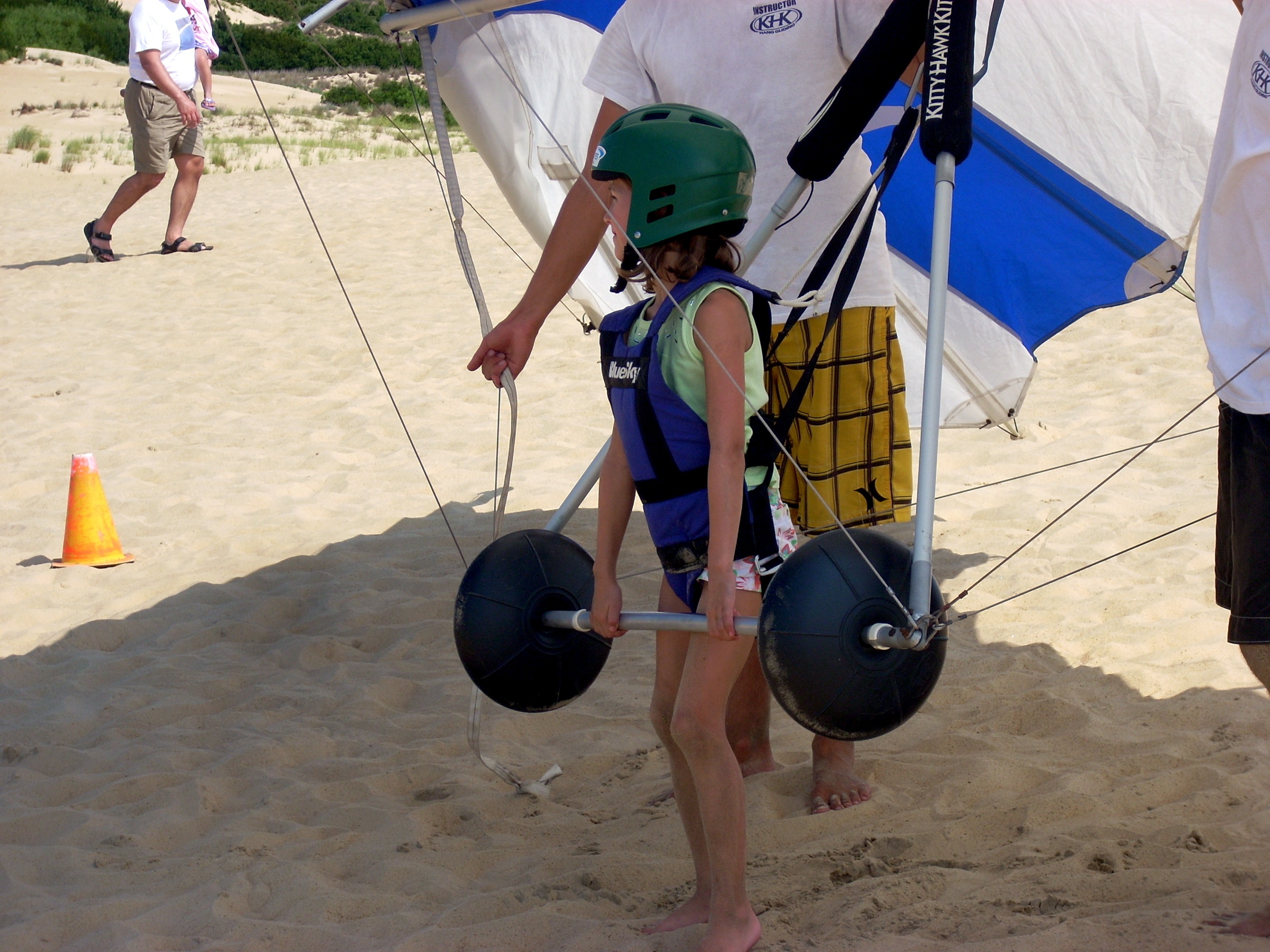 |
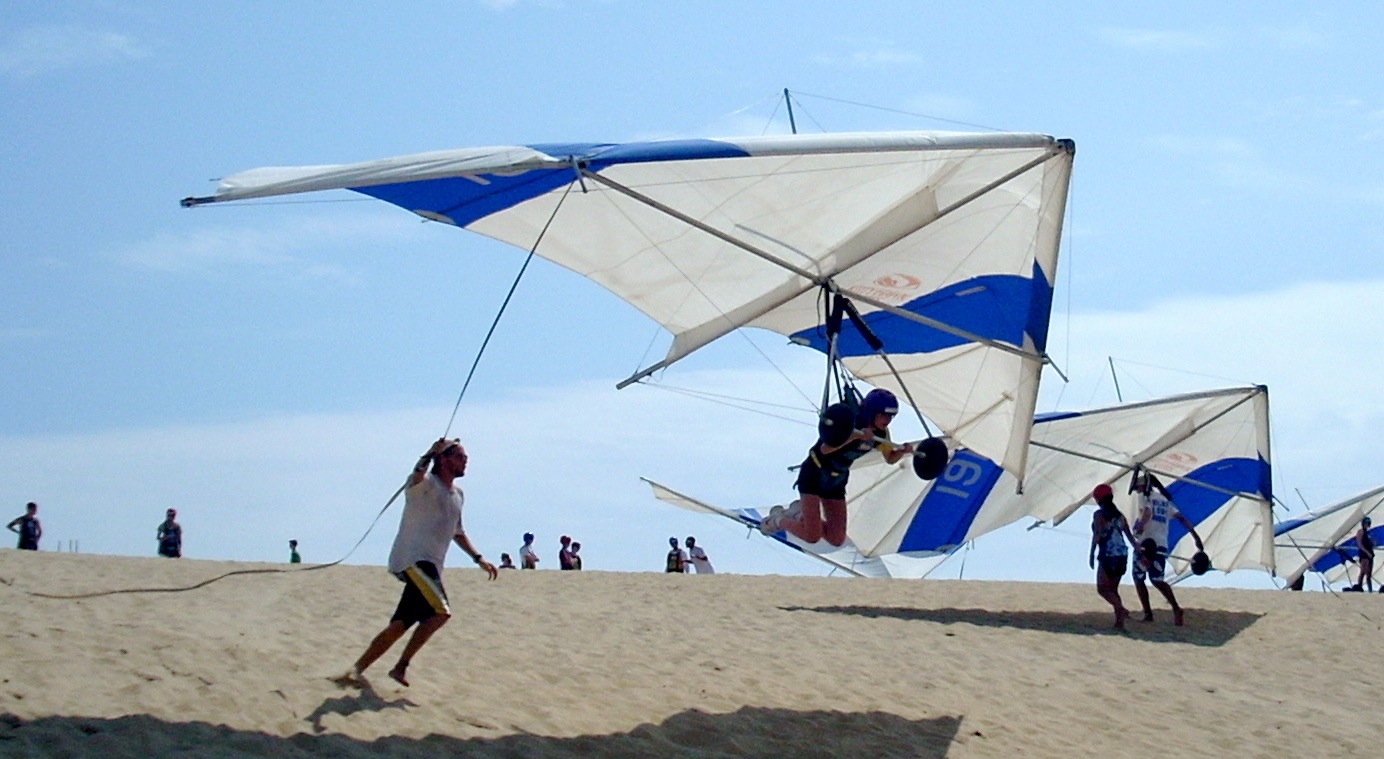 |
Up on top, there's more instruction (above, left). Students are drilled in proper starting procedure. First, there's laying down to clip in to the framework (above center). Then there's standing, both hands on the bar. A sequence of walk - jog - run is used to gain momentum, at which time air should naturally lift the sail and the rider along with it (seen here at left). Anyone thinking this is too overwhelming need only notice the 4th grade girl above right. She performed quite well, thank you, and so did her 6th grade brother. |
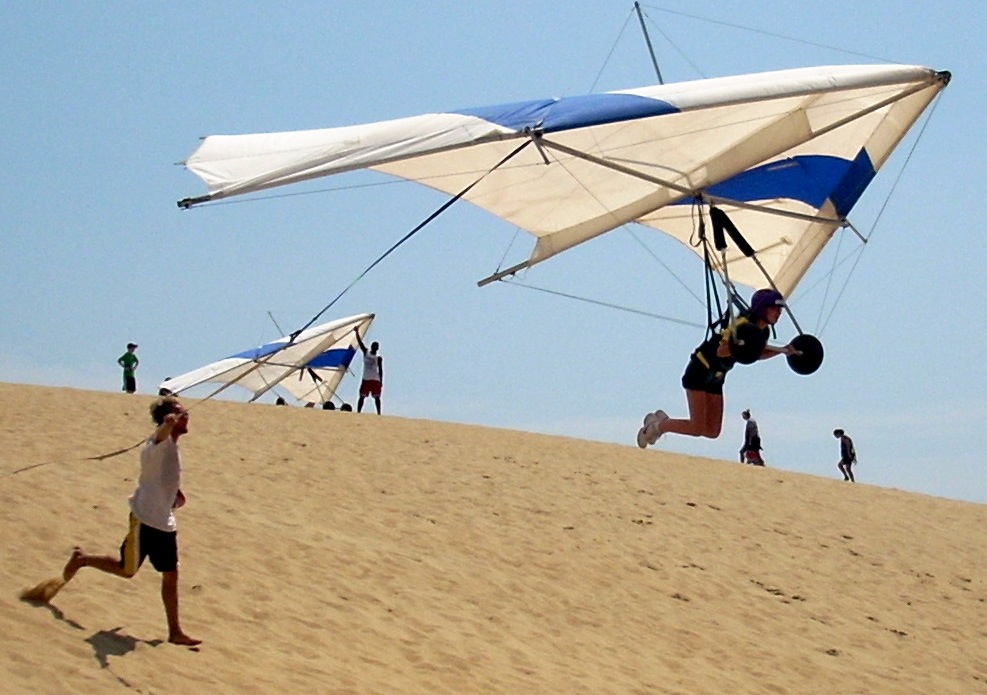 |
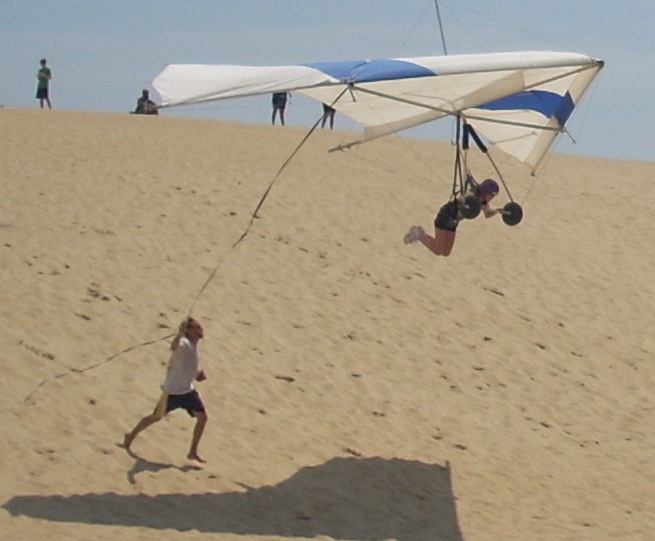 |
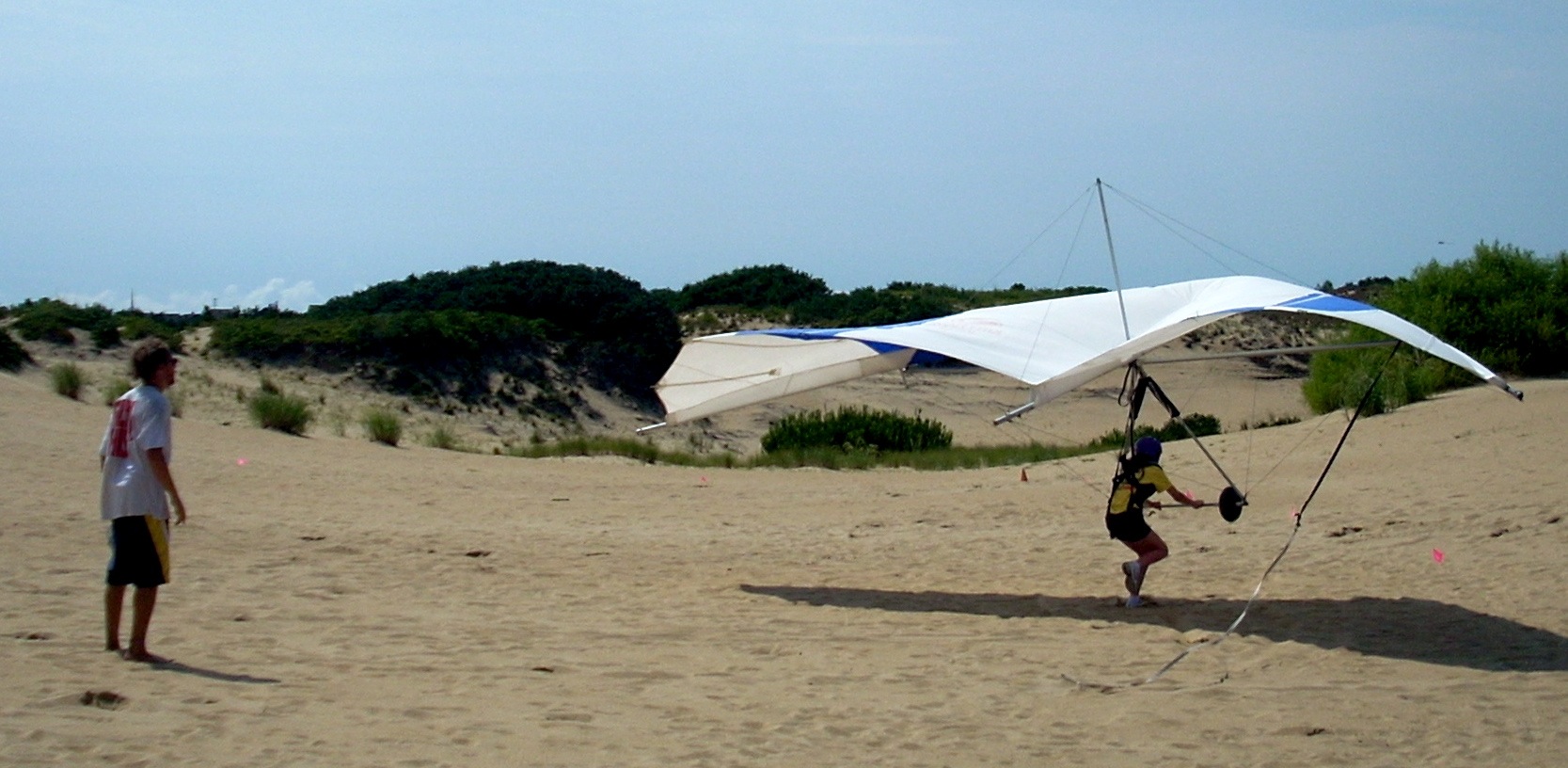 |
| The perfect sequence for a beginning student looks like this. Above left and center, the student gains altitude but maintains a straight flight path as the instructor finally releases the tether. Then, at the bottom, the student comes to a running landing and slowly brings the glider to a halt. Most students find this a nerve wracking challenge with so much to remember and apply in such a short time frame and the danger of crash landing if they make any mistake at all. Therefore, it is quite common for a student once safely landed to just pause for a few minutes while their breathing and heartbeat returns to normal and the instructor comes running down the dune to help them get the rig back to the top. | 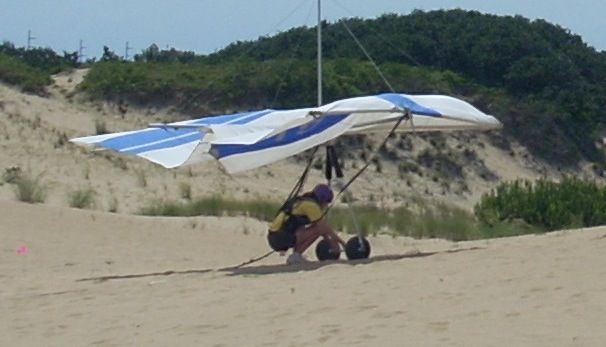 |
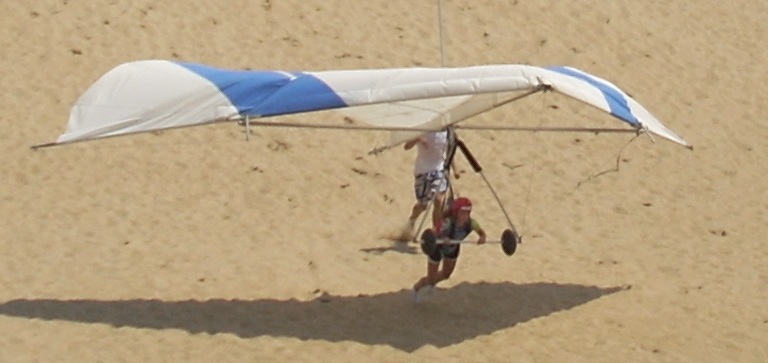 |
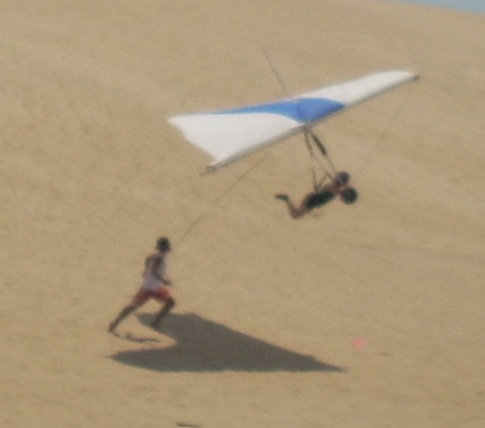 |
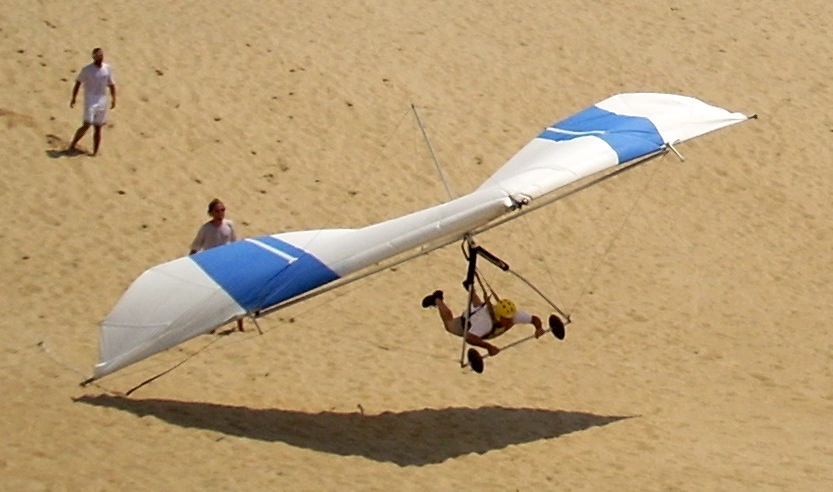 |
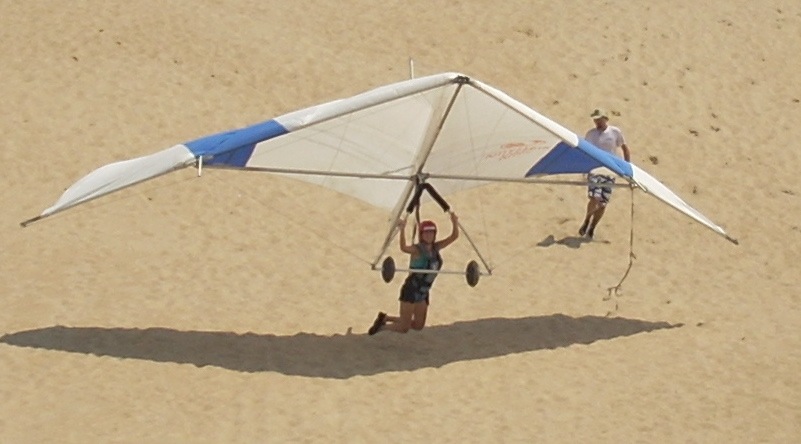 |
Once everyone has made it through their initial flight, the rest of the lesson becomes a matter of repetition. In each group, the students keep rotating turns, working on their weaknesses. Some students are able to move to a higher level. Here, the instructor has taught this flyer to move her hands off the horizontal bar and instead grip the side struts. This allows her more leverage in certain situations. As she comes in for a landing she is raising the struts, thus raising the sail, to bring the rig down to a soft stop while she gathers her legs under her. |
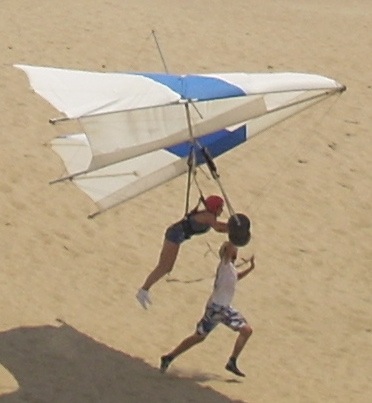 |
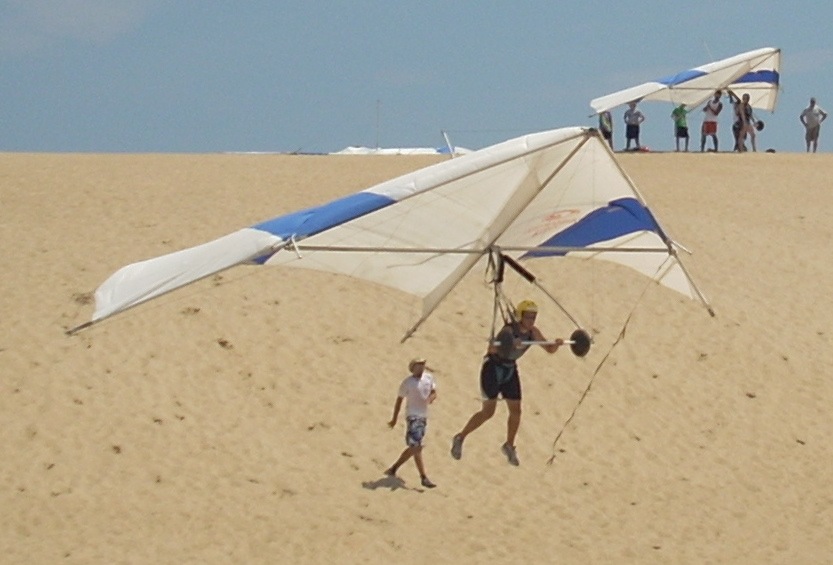 |
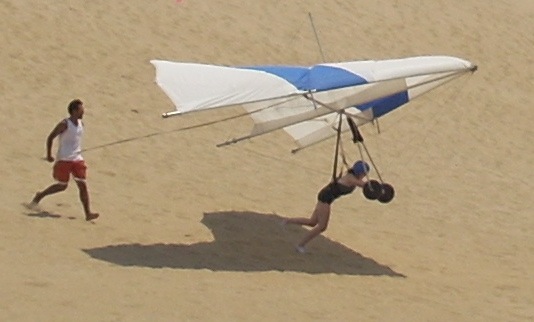 |
| He may still have his hands on the lower bar, but this is a near perfect flight, straight, smooth and balanced. This New Hampshire high school student is making his final flight of the day and finishing on a positive note. | 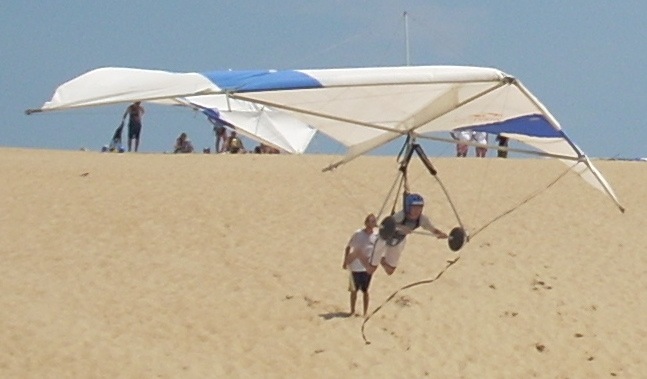 |
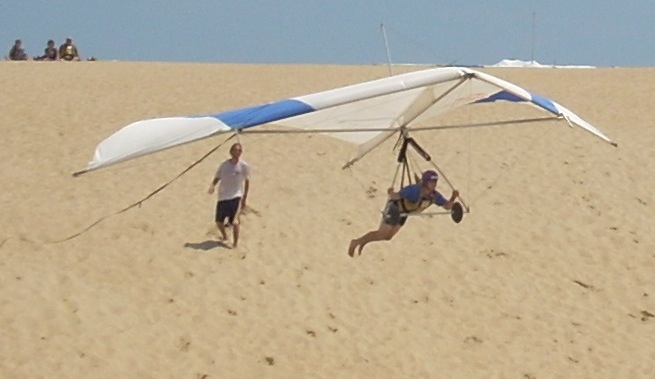 |
Again with her hands on the struts, this girl consistently turned in the best flights of the group. Kitty Hawk Kites offers additional opportunities for students who quickly master basic lessons. They can tow them behind boats out on the sound, tow them behind planes, or take them on special hang gliding trips to the mountains of North Carolina or Virginia. The girl below is a freshman at Gordon College in Massachusetts. This was her first experience with hang gliding but she also turned in solid flights all morning. |
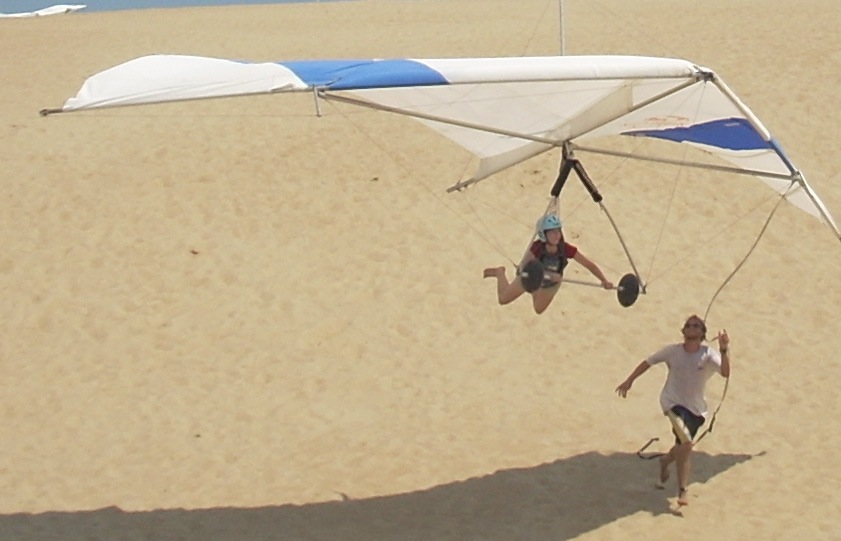 |
|
|||
|